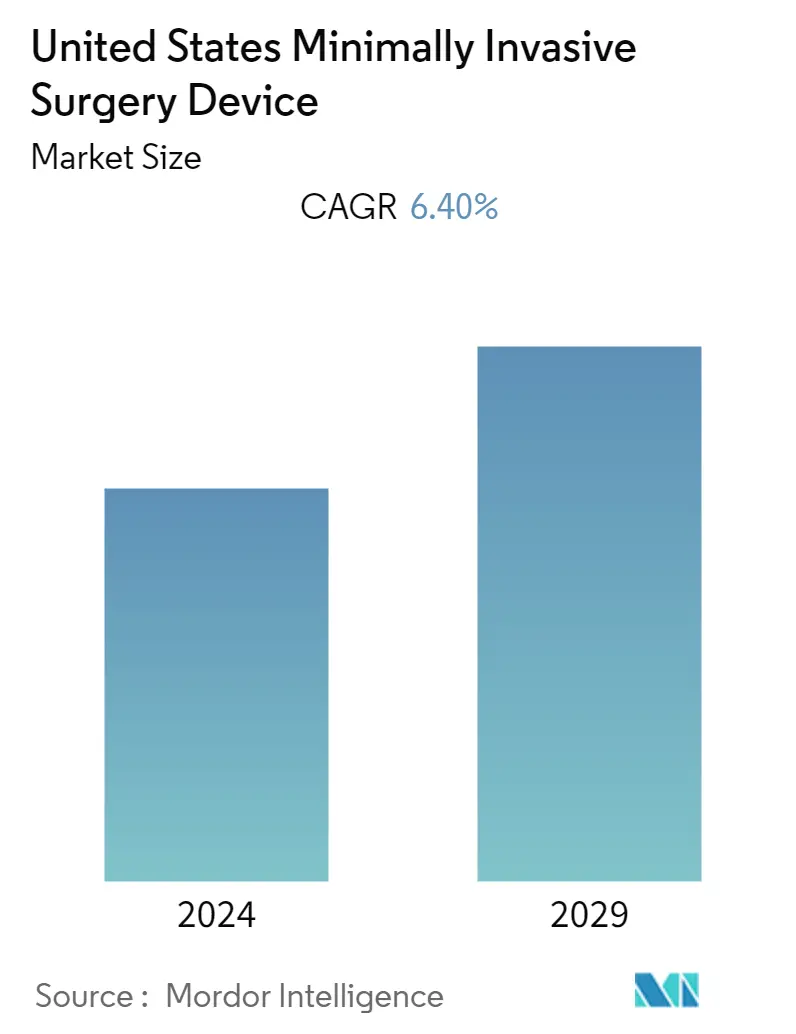Market Size of United States Minimally Invasive Surgery Device

| Study Period | 2019 - 2029 |
| Base Year For Estimation | 2023 |
| Forecast Data Period | 2024 - 2029 |
| Historical Data Period | 2019 - 2022 |
| CAGR | 6.40 % |
Major Players
*Disclaimer: Major Players sorted in no particular order |
US Minimally Invasive Surgery Device Market Analysis
The US minimally invasive surgery device market is expected to register a CAGR of 6.4% over the forecast period.
- The COVID-19 pandemic has had an impact on the US minimally invasive surgery device market initially. The market experienced a moderate decline in growth during the pandemic. It was primarily due to the temporary cancellation of treatment and elective procedures and patient visits to the hospitals for the management of chronic diseases other than COVID-19. The pandemic shifted most of the focus of healthcare and research on COVID-19-related diagnosis and patient care, adversely impacting the country's other medical care areas. For instance, in a study published in the Spine Journal by a researcher at NYU Langone Health, the United States, in December 2021, over one-third of elective spinal surgeries got canceled due to the pandemic. However, in the post-pandemic period, the lifting of the lockdown and gradual resumption of the treatment and patient care for the non-COVID medical areas are expected to restore the normal growth rate of the market. For instance, in a study published in the Annals of Medicine and Surgery by the researchers of the University of California San Diego and Rady Children's Hospital, San Diego, in September 2022, the same-day surgery cancellation decreased after the pandemic. The study hypothesized that the required pre-operative COVID diagnosis enabled healthcare providers to reduce the number of surgery cancellations and meet the requirement of the patients. The market is expected to grow further at a stable pace with the increasing demand for minimally invasive surgical devices in the United States.
- The market is expected to grow with a higher acceptance rate of minimally invasive surgeries over traditional surgeries, increasing prevalence of lifestyle-related and chronic disorders, and technological advancements. The prevalence of chronic diseases is on the rise in the United States, which is expected to create more demand for minimally invasive surgical devices for the management of diseases. For instance, according to data published by the CRT Group Foundation in August 2022, the number of individuals living with hypertension will increase by 27.2% to 162.5 million from 127.8 million during the period of 2025 to 2060. As per the data published by the US Census Bureau in November 2022, more than 34 million adults live with diabetes in the United States, and 88 million more individuals are at risk of developing the disease. Several studies have underlined the advantage of minimally invasive surgical devices, which promotes the adoption of these devices for performing surgical interventions.
- A study published in the Frontiers in Robotics and AI by researchers of New York University in January 2022 highlighted the advantages offered by minimally invasive surgical devices, such as shorter hospital stays, decreased postoperative pain, better and faster recovery, and decreased learning curve for the surgical trainees. As per a study published in the JAMA Network by researchers from the United States in September 2022, minimally invasive nephrectomy showcased better efficacy and cost-effectiveness. Thus, with the increasing number of chronic diseases, the advantage of minimally invasive surgeries and devices, and the demand for minimally invasive surgical devices, the market is expected to grow further during the forecast period in the United States.
- Therefore, owing to the aforementioned factors, the market studied is anticipated to witness growth over the analysis period. However, the shortage of experienced professionals and uncertain regulatory frameworks are likely to impede the market's growth.
US Minimally Invasive Surgery Device Industry Segmentation
As per the scope of this report, minimally invasive surgical devices refer to surgical equipment and devices used for performing minimally-invasive surgeries. The minimally-invasive surgeries performed using these devices offer faster recovery after surgery, minimal pain, shortened hospital stay, and high accuracy.
The US minimally invasive surgery device market is segmented by products (handheld instruments, guiding devices, electrosurgical devices, endoscopic devices, laproscopic devices, robotic-assisted surgical systems, ablation devices, laser-based devices, and other MIS Devices) and applications (aesthetic, cardiovascular, gastrointestinal, gynecological, orthopedic, urological, and other applications). The report offers the value (in USD million) for the above segments.
| By Products | |
| Handheld Instruments | |
| Guiding Devices | |
| Electrosurgical Devices | |
| Endoscopic Devices | |
| Laproscopic Devices | |
| Robotic Assisted Surgical Systems | |
| Ablation Devices | |
| Laser Based Devices | |
| Other MIS Devices |
| By Application | |
| Aesthetic | |
| Cardiovascular | |
| Gastrointestinal | |
| Gynecological | |
| Orthopedic | |
| Urological | |
| Other Applications |
United States Minimally Invasive Surgery Device Size Summary
The US minimally invasive surgery device market is poised for growth, driven by an increasing acceptance of these procedures over traditional surgeries, the rising prevalence of lifestyle-related and chronic disorders, and ongoing technological advancements. The market experienced a temporary setback during the COVID-19 pandemic due to the postponement of elective procedures and a shift in focus towards COVID-19 care. However, the post-pandemic recovery has been marked by a resurgence in non-COVID medical care, which is expected to restore and enhance the market's growth trajectory. The demand for minimally invasive surgical devices is further bolstered by their advantages, such as shorter hospital stays, reduced postoperative pain, and faster recovery times, which are increasingly recognized in clinical studies. This trend is anticipated to continue as the prevalence of chronic diseases like hypertension and diabetes rises, necessitating more surgical interventions.
The laparoscopic and gastrointestinal segments are expected to witness significant growth, fueled by the broad application of minimally invasive techniques in diagnosing and treating various medical conditions. Laparoscopic devices, in particular, are gaining traction due to their technological advancements and effectiveness in reducing complications such as septic shocks in specific patient populations. The gastrointestinal segment is also set to expand, driven by the increasing incidence of gastrointestinal diseases and the proven safety and efficacy of minimally invasive procedures. The competitive landscape of the market is characterized by the presence of numerous global and regional players, with companies like Olympus Corporation, Medtronic PLC, and GE HealthCare leading the charge. Recent strategic moves, such as acquisitions and funding rounds, are expected to further strengthen the market's growth prospects.
United States Minimally Invasive Surgery Device Market Size - Table of Contents
-
1. MARKET DYNAMICS
-
1.1 Market Overview
-
1.2 Market Drivers
-
1.2.1 Higher Acceptance Rate of Minimally Invasive Surgeries over Traditional Surgeries
-
1.2.2 Increasing Prevalence of Lifestyle-related and Chronic Disorders
-
-
1.3 Market Restraints
-
1.3.1 Shortage of Experienced Professionals
-
1.3.2 Uncertain Regulatory Framework
-
-
1.4 Industry Attractiveness - Porter's Five Force Analysis
-
1.4.1 Threat of New Entrants
-
1.4.2 Bargaining Power of Buyers/Consumers
-
1.4.3 Bargaining Power of Suppliers
-
1.4.4 Threat of Substitute Products
-
1.4.5 Intensity of Competitive Rivalry
-
-
-
2. MARKET SEGMENTATION (Market Size by Value - USD million)
-
2.1 By Products
-
2.1.1 Handheld Instruments
-
2.1.2 Guiding Devices
-
2.1.3 Electrosurgical Devices
-
2.1.4 Endoscopic Devices
-
2.1.5 Laproscopic Devices
-
2.1.6 Robotic Assisted Surgical Systems
-
2.1.7 Ablation Devices
-
2.1.8 Laser Based Devices
-
2.1.9 Other MIS Devices
-
-
2.2 By Application
-
2.2.1 Aesthetic
-
2.2.2 Cardiovascular
-
2.2.3 Gastrointestinal
-
2.2.4 Gynecological
-
2.2.5 Orthopedic
-
2.2.6 Urological
-
2.2.7 Other Applications
-
-
United States Minimally Invasive Surgery Device Market Size FAQs
What is the current United States Minimally Invasive Surgery Device Market size?
The United States Minimally Invasive Surgery Device Market is projected to register a CAGR of 6.40% during the forecast period (2024-2029)
Who are the key players in United States Minimally Invasive Surgery Device Market?
Olympus Corporation, Medtronic PLC, GE Healthcare, Siemens Healthineers and Smith & Nephew are the major companies operating in the United States Minimally Invasive Surgery Device Market.

